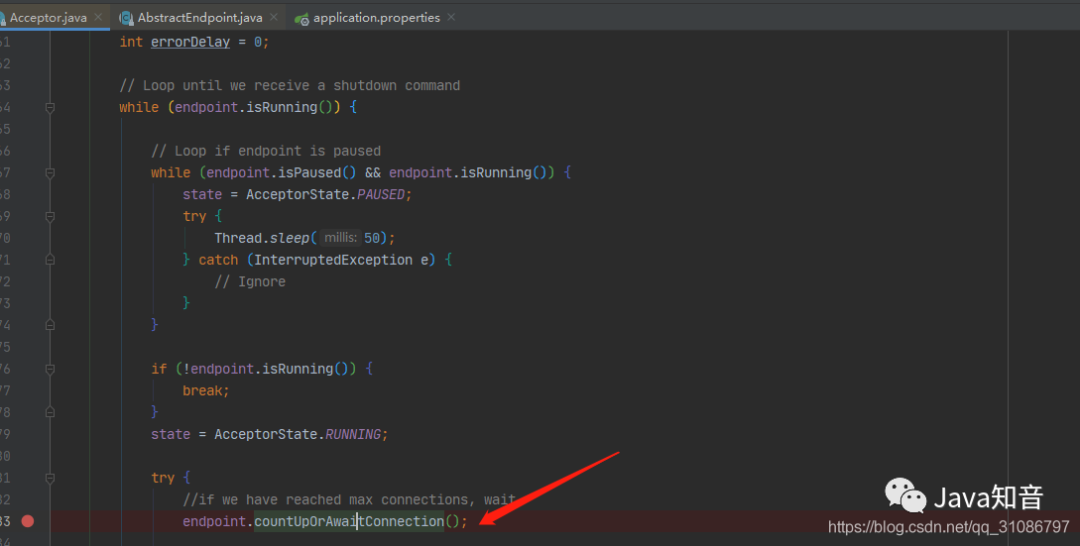书名镜像:https://mp.weixin.qq.com/s/FPMT6kUNGD2VmzBE8zgRgQ
序言
责任编辑导出springboot内建tomcatListarymammalian缓存数的许多模块,并紧密结合源代码展开预测
模块
缓存池核心理念缓存数
server.tomcat.min-spare-threads:该模块为tomcat处置销售业务的核心理念缓存数大小不一,缺省为10
缓存池最小缓存数
server.tomcat.max-threads:该模块为tomcat处置销售业务的最小缓存数大小不一,缺省为200,当对mammalian量有一点值时能调大该模块
允诺最小通话量
server.tomcat.max-connections:该模块为允诺的最小通话量,缺省为10000,特别注意那个模块并并非增设在缓存横山的,而要在tomcat的Acceptor类(专门针对处置相连的缓存类)来掌控的,紧密结合源代码他们能看见

protectedvoidcountUpOrAwaitConnection()throwsInterruptedException{if(maxConnections==-1)return;
LimitLatch latch = connectionLimitLatch;if(latch!=null) latch.countUpOrAwait();
}
能看见当最小通话量满了后会展开等候
accept-count
server.tomcat.accept-count:那个模块事实上和tomcat没太大亲密关系,缺省为100
他们先看下文档的定义
/**
* Allows the server developer to specify the acceptCount (backlog) that
* should be used for server sockets. By default, this value
* is 100.
*/privateintacceptCount =100;
那个模块是服务端创建ServerSocket时操作系统掌控同时相连的最小数量的,服务端接收相连是通过accept()来的,accept()是非常快的,所以accept-count的不需要太大,正常保持缺省100即可了,acceptCount那个模块和缓存池无关,会被映射为backlog模块,是socket的模块,在源代码的使用是在NioEndpoint类的initServerSocket方法,在tomcat中的名字是backlog在springboot内建tomcat中名字没使用backlog而要使用acceptCount
serverSock.socket().bind(addr,getAcceptCount())
protectedvoidinitServerSocket()throwsException{if(!getUseInheritedChannel()) {
serverSock = ServerSocketChannel.open();
socketProperties.setProperties(serverSock.socket());
InetSocketAddress addr = (getAddress()!=null?newInetSocketAddress(getAddress(),getPort()):newInetSocketAddress(getPort()));// 核心理念代码serverSock.socket().bind(addr,getAcceptCount());
}else{// Retrieve the channel provided by the OSChannel ic = System.inheritedChannel();if(icinstanceofServerSocketChannel) {
serverSock = (ServerSocketChannel) ic;
}if(serverSock ==null) {thrownewIllegalArgumentException(sm.getString(“endpoint.init.bind.inherited”));
}
}
serverSock.configureBlocking(true);//mimic APR behavior}
tomcat缓存池处置机制
tomcat最终使用缓存池来处置销售业务逻辑,java默认的缓存池的规则:
核心理念缓存数满了则优先放入队列,当队列满了后才会创建非核心理念缓存来处置,那么tomcat是这样做的吗?
首先如果tomcat这样做,那么当达到核心理念缓存后后续任务就需要等候了,这显然是不合理的,他们通过源代码来看下tomcat是如何处置的
在AbstractEndpoint的createExecutor创建了处置销售业务数据的缓存池
publicvoidcreateExecutor(){
internalExecutor =true;
TaskQueue taskqueue =newTaskQueue();
TaskThreadFactory tf =newTaskThreadFactory(getName() “-exec-“, daemon, getThreadPriority());
executor =newThreadPoolExecutor(getMinSpareThreads(), getMaxThreads(),60, TimeUnit.SECONDS,taskqueue, tf);
taskqueue.setParent( (ThreadPoolExecutor) executor);
}
主要是使用了TaskQueue队列,ThreadPoolExecutor并并非jdk的,而要tomcat重写的。
他们从缓存池的处置方法execute看起
publicvoidexecute(Runnable command){
execute(command,0,TimeUnit.MILLISECONDS);
}publicvoidexecute(Runnable command,longtimeout, TimeUnit unit){
submittedCount.incrementAndGet();try{// 核心理念代码super.execute(command);
}catch(RejectedExecutionException rx) {if(super.getQueue()instanceofTaskQueue) {finalTaskQueue queue = (TaskQueue)super.getQueue();try{if(!queue.force(command, timeout, unit)) {
submittedCount.decrementAndGet();thrownewRejectedExecutionException(“Queue capacity is full.”);
}
}catch(InterruptedException x) {
submittedCount.decrementAndGet();thrownewRejectedExecutionException(x);
}
}else{
submittedCount.decrementAndGet();throwrx;
}
}
}
又调用会jdk的execute了
publicvoidexecute(Runnable command){if(command ==null)thrownewNullPointerException();intc = ctl.get();// 1、工作缓存数小于核心理念缓存数则添加任务,核心理念缓存会处置if(workerCountOf(c)
2.分享目的仅供大家学习和交流,您必须在下载后24小时内删除!
3.不得使用于非法商业用途,不得违反国家法律。否则后果自负!
4.本站提供的源码、模板、插件等其他资源,都不包含技术服务请大家谅解!
5.如有链接无法下载或失效,请联系管理员处理!
6.本站资源售价只是赞助,收取费用仅维持本站的日常运营所需!
